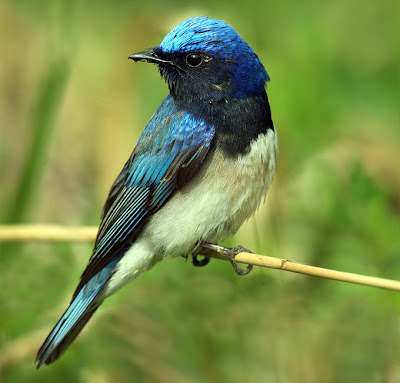Cyanoptila cyanomelana
 |
| Photo by Robin Newlin (Birds Korea) |
Common name:
blue-and-white flycatcher (en); papa-moscas-azul-e-branco (pt); gobemouche bleu (fr); papamoscas blanco y azul (es); Japanschnäpper (de)
Taxonomy:
Order Passeriformes
Family Muscicapidae
Range:
This species breeds in north-eastern China, extreme south-eastern Russia, Korea and Japan, migrating south to winter in Vietnam, Cambodja, Thailand, Indonesia and the Philippines.
Size:
These birds are 16-17 cm long and weigh 22-25 g.
Habitat:
The blue-and-white flycatcher breeds in various wooded habitats, namely taiga, moist forests and swamp forests, but also in moist scrublands, from sea level up to an altitude of 1.200 m. During migration and winter they are found in tropical forests, scrublands and also coastal woodlands, plantations, parks and gardens within rural and urban areas.
Diet:
They mainly feed on larval and adult insects, mostly moths and beetles, but will also take berries when in season.
Breeding:
The blue-and-white flycatcher breeds in May-August. The cup-shaped nest is made of moss, plant fibres and lichens, and placed near the ground, in a rock crevice, among the roots of a tree, or under the overhanging bank of a stream, often sheltered by vegetation or branches. There the female lays 4-6 pale brown eggs with darker markings, which she incubates alone for roughly 14 days. The chicks are fed by both parents.
Conservation:
IUCN status - LC (Least Concern)
This species has a very large breeding range and is described as common to locally common in most of this range, but uncommon in China, Thailand and the Philippines. The population is suspected to be stable in the absence of evidence for any declines or substantial threats.
No comments:
Post a Comment